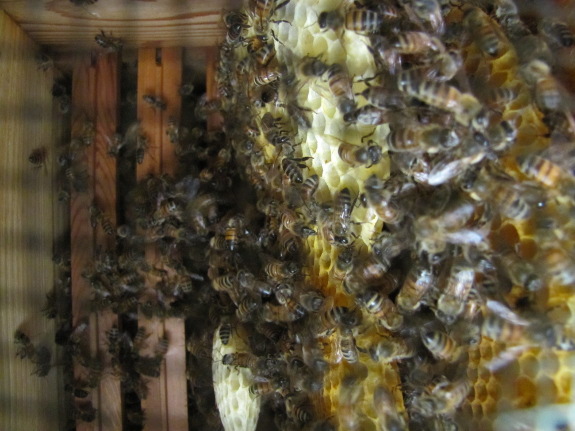
How to get new honeybees

It's best to have at
least two hives of honeybees, so one of my goals
for this year is to double the size of our apiary. How exactly to
do that has
been an issue I've been pondering for months. Here are your main
options for getting new bees:
- Split an existing hive.
I've done this before with good luck, but it does have three
downsides. First, Warre hive enthusiasts believe you shouldn't
open the hive more than once a year, and splitting is
majorly intrusive. Second, since we're in the very early stages
of developing a chemical-free apiary, splitting wouldn't give us much genetic
diversity.
(The queen for the new hive would have the queen from the old hive as
her mother, and would likely mate with drones from the old hive since
we're pretty isolated back here in the woods. Inbreeding can be
good...or it can be bad.) And, finally, we probably wouldn't get
much, if any honey, this year if we split the hive.
- Catching a swarm. This is the Warre-approved method of getting new bees from your current hive. If we don't split our current hive, chances are it will swarm this spring because the bees seem to have already filled two boxes and are working on their third. Putting up a swarm-attractant box could help capture that swarm. This is chancy, of course, and has the same genetic problems as the option above, but is definitely worth a shot.
- Buying a new package.
After long thought, we've decided to go with a new package this
spring. I found a new
source of chemical-free bees in Maryland
(whose bees are actually raised in the mountains of Tennessee and
Georgia --- pretty close to us). The proprietors explained that
their bees are a mix of Carniolan and Russian varieties that have been
raised on small
cell and natural comb without chemicals for several
years, so the ones that survived are better adapted to living without
miticides and other pharmaceuticals.
In the long run, our
goal is for the apiary to be self-sustaining, but
since we've only got one hive at the moment, paying for a new package
this year makes sense. Stay tuned for the big install next week!
Want more in-depth information? Browse through our books.
Or explore more posts by date or by subject.
About us: Anna Hess and Mark Hamilton spent over a decade living self-sufficiently in the mountains of Virginia before moving north to start over from scratch in the foothills of Ohio. They've experimented with permaculture, no-till gardening, trailersteading, home-based microbusinesses and much more, writing about their adventures in both blogs and books.
Want to be notified when new comments are posted on this page? Click on the RSS button after you add a comment to subscribe to the comment feed, or simply check the box beside "email replies to me" while writing your comment.

Brian --- The swarm attractant box is definitely going on the list. Let's hope I make time for it before the swarm! So, in a perfect world, we'll be going into fall with three hives.
Stephen --- The "chemical" part isn't that bees have been sprayed with chemicals, but that most honeybees in the U.S. have been raised with pharmaceuticals for so long that they can't survive without them. Specifically, varroa mites are so bad in the U.S. that most people treat their bees annually for mites as a matter of course. I should have linked to this post about chemical-free bees for more information.